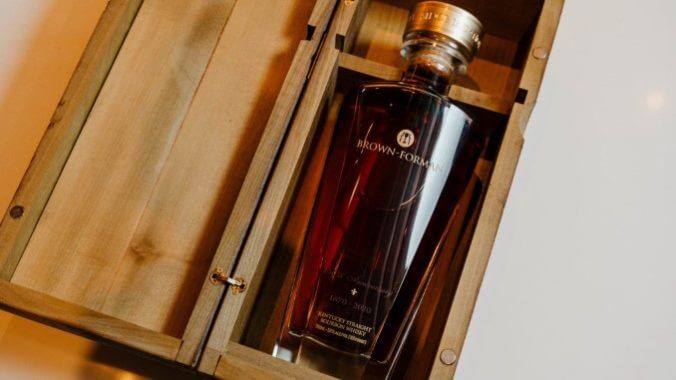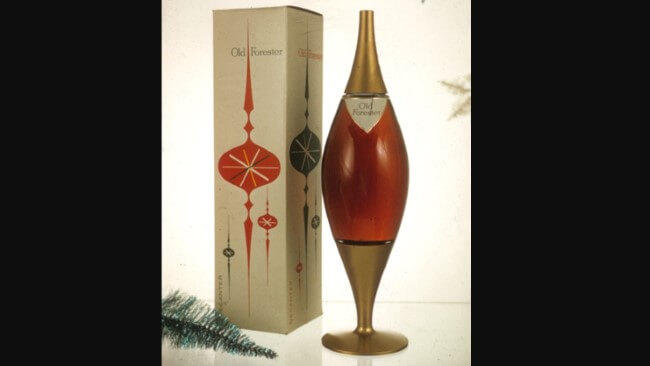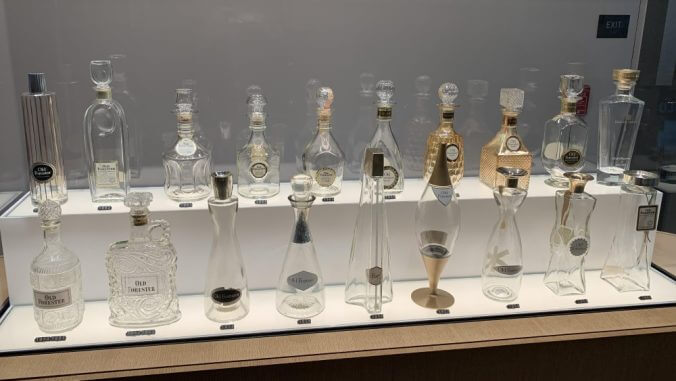Bourbon History, Decanted: A Weekend at Old Forester
Photos via Old Forester, Brown-Forman, Jim Vorel
When I think of Old Forester Bourbon, what comes to mind first is the spirit of tenacity.
Old Forester is a survivor, though this may not immediately be obvious to the consumer. Looking at some of the brand’s claims to fame–its status as the first exclusively bottled bourbon brand, the fact that it’s the only bourbon brand in the entire category to never once leave shelves in the last 153 years–one might leap to the assumption that it has been a relatively smooth ride for Old Forester. But in truth, it’s often been the opposite. Old Forester has been made to weather all storms, from federal Prohibition, to destructive fires, to the bottoming out of the American whiskey market, to the COVID-19 pandemic. It’s seen its market share grow to impressive heights and then shrink to a mere 10% of its former volume at its lowest point in the 1970s, before coming roaring back once more. The consumer might just see stolid consistency, but the reality is that Old Forester has been on quite a ride in this last century and a half, and only the dedicated stewardship of Brown-Forman and the Brown family has seen it through to where it is today.
It was fitting, then, that the brand planned a grand tribute to its most critical members as part of its 150th anniversary celebrations in 2020 … only to see the pandemic completely upend the public announcement of those plans, resulting in a once-in-a-lifetime bottling that was left collecting dust, with Old Forester’s leadership unsure of how to proceed. That is, until earlier this month when the Brown-Forman 150th Anniversary decanters were revealed in a surprise public sale, instantly selling out despite a gaudy $2,500 price tag. Thankfully, Paste had an opportunity to both sample this ultra-limited liquid, and cultivate a deeper appreciation for what makes it so unique, during a weekend spent at the Old Forester Distilling Co. in Louisville.
The Legacy of the Bourbon Decanter
It’s sort of funny to consider how a word you’re perfectly familiar with can have a meaning that is decidedly nebulous once you start actively thinking about it. Consider: What is the actual definition of a decanter? In the wine world, this is more easily categorized–a decanter is a glass container into which one decants a bottle of wine, to encourage oxidation as you drink it. The same can of course be done with spirits at home, but what about a commercial spirit release, such as bourbon, that is sold in a “decanter” bottle? What, if anything, really separates that bottle from any other commercial bottling?
At the end of the day, the most important answer is deceptively simple: It’s design aesthetic that makes the difference. A commercial “decanter bottle” is not necessarily any different in the sense of how the whiskey inside it is meant to age, oxidize or be consumed. Rather, the primary function of a decanter is for display, for aesthetic appeal, and to show off the beauty of the spirit within. This makes the concept of a commercial decanter release an obvious opportunity for a whiskey brand to advertise and highlight its aesthetic aspirations, and such was the case for Old Forester in particular.
In the postwar American spirits world, decanters were a common sight–many of the large Kentucky bourbon powerhouses, such as Jim Beam, sold exceedingly ornate yearly decanter releases, often associated with the holiday season. But these decanters had something more of a kitsch appeal to them–they were often gaudy, colorful and intensely designed ceramic bottles, made to look like other household objects, baubles or animals as if the goal was to hide the liquor they contained. Old Forester sold decanters in this style as well, but the trajectory of their holiday decanter series was forever altered in the early 1950s when the company brought on the firm of legendary designer Raymond Loewy, the “father of industrial design,” to oversee the series from scratch. What followed was a much more modern, fluid and elegant series of holiday decanter releases in the 1950s and 1960s, exemplifying the mid-century modern aesthetic. Perhaps most enduringly famous today is the teardrop-shaped 1957 “Sputnik” decanter, a happy accident that had been designed well in advance of the launch of the first satellite, but was hastily reworked with new marketing to capitalize on the launch of the Space Race.

On some level, it may be difficult for modern bourbon geeks to wrap their heads around certain aspects of these decanter releases. For one thing, whiskey geeks might be surprised to find that the whiskey in these decanters wasn’t actually anything “rare” or out of the ordinary–instead, it was the flagship Old Forester Bourbon product. Nor did the decanters bear elevated sticker prices, costing exactly the same as the core product always did. The fundamental difference is that they weren’t designed to cash in on a craze for “limited edition” bourbon, as has become so common in the modern whiskey world, but as a method of advertising the brand by creating a striking vessel that was designed to be consumed and then re-used by the consumer for years to come. To this end, the company even sold conversion kits that would show a drinker exactly how to turn their Old Forester decanter into a lamp once it was empty. Families held on to these decanters for decades, which actually makes them surprisingly easy to find today on sites such as eBay or Etsy.
To celebrate its momentous 150th anniversary in 2020, meanwhile, Brown-Forman and Old Forester envisioned the release of a very special, extremely limited bourbon decanter that would harken back to the vintage designs of Raymond Loewy. Six barrels of 12.5 year old bourbon–always a rarity, to see age statements from Brown-Forman or Old Forester–comprised the decanter release, with 500 of the resulting bottles earmarked for members of the Brown family and key partners of the company. The remaining 150 decanter bottles were intended to be used in a series of special events and tastings hosted by the company … but the COVID pandemic came along and made such in-person events an impossibility. It took until now, in the autumn/winter of 2023 for the bottles to reappear, presented in custom, handmade wooden boxes from materials that were recovered from the fire that almost destroyed the Old Forester distillery on Whiskey Row in 2015.
It likely goes without saying that the liquid inside these decanters is something special, with a nose redolent in spiced caramel candies and honeycomb, along with fudge, vanilla and hints of herbal rye and tobacco. The palate is rich in honey, caramel and confectionery-like notes, into cardamom spice, leather, juicy red fruit and cigar wrapper, with a slightly bitter, herbal edge. It’s a special expression of Brown-Forman bourbon that few American whiskey geeks will sadly ever have a chance to experience, though you might get lucky enough to find a business pouring it by the dram.
The good news, for consumers? It is at least still possible to experience the flavor of other historic Old Forester batches from decades or even a century ago–and that experience requires no more than opening a bottle of the distillery’s flagship products that are still produced today. This is a testament to the particularly unchanging nature of Old Forester as a brand–it still uses the same single bourbon mash bill it utilized before Prohibition, and both its bourbon and rye are initially fermented with a single yeast strain that was isolated more than 100 years ago, being continuously propagated ever since. Samples from the Brown-Forman archives bear this out: Paste was given the opportunity to smell a scientific sample dated to the period between 1905-1919, and the familiarity is unmistakable. Even the whiskey from more than 100 years ago still smells distinctly like modern Old Forester. Even in an industry so often built on tradition, this is still a pretty remarkable thing.

So too can visitors to Kentucky in 2023-2024 experience a similar deep-dive into the history of Old Forester’s vintage holiday decanters by visiting downtown Louisville’s Frazier Museum–the official starting point of the Kentucky Bourbon Trail–which is hosting a special year-long exhibit displaying the entire range of mid-century decanter bottles, along with presentations on how they were designed each year by Raymond Loewy’s firm. Of course, you might also catch a glimpse of the vintage decanter series while conducting a tour and tasting at Old Forester’s working distillery on Whiskey Row, where one can also be educated on each step of the fermentation and distillation process, or watch a new white oak barrel slowly come together in their impressive miniaturized cooperage.
Today, the Old Forester brand is a thriving, featured element of the wider Brown-Forman bourbon portfolio, particularly loved by cocktail aficionados and the kind of high-end whiskey geeks who have the ability to shape public perception in the industry. The brand leans on the strength of its history, and why wouldn’t it–no one else can claim to have continuously had their product on store shelves, practically unchanging, for the last 150 years. Decanted or not, it’s a legacy that you can’t help but respect.
Jim Vorel is a Paste staff writer and resident beer and liquor geek. You can follow him on Twitter for more drink writing.







































